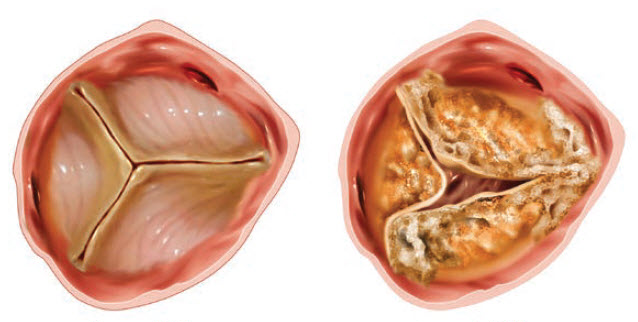Position of the Aortic Valve in the Heart
Normal Aortic Valve Stenotic Aortic Valve
Images courtesy of Medtronic
Aortic Valve Disease
The aortic valve lies between the left ventricle and that aorta (the largest blood vessel in the body that carries blood to the body from the heart). In some cases, the aortic valve is abnormal from birth. The valve can also become damaged by rheumatic fever, infection, or degenerate with age.
Like all other valve diseases, aortic valve disease can be either stenosis (AS) or regurgitant, known as either aortic regurgitation (AR) or more commonly as aortic insufficiency (AI).
Aortic Stenosis
Aortic stenosis is one of the most common and most serious of the valve diseases. It is the narrowing of the valve opening that restricts blood from the left ventricle to the rest of the body. Aortic stenosis mainly affects older people as a result of years of calcium buildup, but it can also affect younger people who have a congenitally abnormal aortic valve.
Often, aortic stenosis goes undetected until it has become severe and the amount of blood sent to the body is significantly reduced. The most common symptom is shortness of breath, initially with activity but can progress to resting symptoms. Sometimes, a syncopal, or fainting, episode is the first indication that a patient has severe aortic stenosis. Left untreated, aortic stenosis leads to thickening of the heart muscle and eventually to heart failure.
Aortic Insufficiency or Regurgitation
Aortic insufficiency or regurgitation is a condition where the valve does not close properly because the valve leaflet tissue becomes weakened or floppy over time. This allows blood to leak back into the left ventricle, the main pumping chamber of the heart, decreasing the efficiency of the heart and causing it to work harder. Over time, this will lead to dilation of the left ventricle and subsequently to heart failure.. Hypertension (high blood pressure), endocarditis (bacterial infections of the valve itself), or cardiac injury also can contribute to aortic insufficiency.
Signs and Symptoms of Aortic Valve Disease
Since aortic valve disease is a progressive condition, you may experience no symptoms for years until the heart is no longer capable of compensating for the decreased heart function. When symptoms are present, they may include:
- Fatigue and weakness, especially when you increase your activity level
- Shortness of breath with exertion or when you lie down
- Swollen ankles and feet (edema)
- Chest pain (angina), discomfort or tightness
- Lightheadedness or fainting
- Irregular pulse
- Heart murmur
- Sensations of a rapid, fluttering heartbeat


